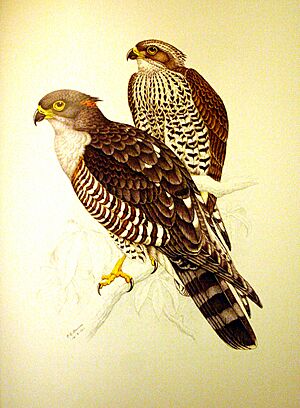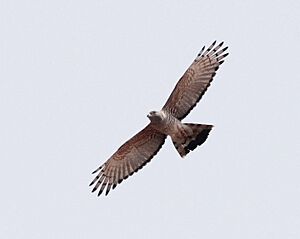African cuckoo-hawk facts for kids
Quick facts for kids African cuckoo-hawk |
|
|---|---|
 |
|
| Conservation status | |
| Scientific classification | |
| Genus: |
Aviceda
|
| Species: |
cuculoides
|
| Subspecies | |
|
|
The African cuckoo-hawk, also known as the African baza, is a medium-sized raptor. It belongs to the Accipitridae family, which includes eagles and hawks. This bird gets its name because it looks a bit like a common cuckoo. You can find it in many parts of Africa, especially in thick woodlands and forests.
Contents
What Does the African Cuckoo-Hawk Look Like?
Male African cuckoo-hawks are dark brownish-black on top. They have a grey back and chest, plus a dark crest on their head. Their belly is white with wide, reddish-brown stripes. Their tail is black with three grey stripes and a grey and white tip.
Female cuckoo-hawks are a bit browner. Their belly stripes are also lighter. When flying, they look like a small raptor. They have a small head, wide, rounded wings, and a medium-length tail. Their wingspan is more than twice their body length. Females are usually a little bigger than males.
Where Do African Cuckoo-Hawks Live?
The African cuckoo-hawk lives across much of Africa, south of the Sahara Desert. There are different types, called subspecies. Each subspecies lives in a specific area:
- A. c. cuculoides: Found from Senegal to southwestern Ethiopia. Also in the northern DRC.
- A. c. batesi: Lives from Sierra Leone to Uganda. You can also find it in northern Angola.
- A. c. verreauxii: Stretches from Kenya to Namibia. It also lives in eastern South Africa.
What Kind of Places Do They Like?
The African cuckoo-hawk is a shy bird. It prefers to live inside or at the edges of evergreen forests. It also likes deciduous woodlands, where trees lose their leaves. Sometimes, you can even spot them in suburban gardens. They can live in open savannas too, up to 3,000 meters (about 9,800 feet) high. When they travel through East Africa, they might also be seen in drier woodlands and bush areas.
How Do African Cuckoo-Hawks Live?
African cuckoo-hawks usually stay in one place. However, some birds migrate north. They travel to East Africa, especially coastal Kenya, from April to November. Outside the breeding season, some also fly to southern Africa. This is common in the Transvaal Highveld.
When Do They Have Babies?
The breeding season changes depending on where they live. In southern Africa, they breed from September to March. In West Africa, it's from June to August. In Kenya, they have two breeding periods each year. One is from March to June, and the other is from November to February. These times usually follow the two rainy seasons.
What Do They Eat and How Do They Hunt?
African cuckoo-hawks mostly eat reptiles and insects. They hunt by flying from tree to tree within the forest canopy. They search for food from a high perch. Once they spot something, they fly down to grab it. They can pluck prey from the tree branches or the ground.
Their diet can include many different things:
- Flap-necked chameleons
- Southern dwarf chameleons
- Lizards and snakes
- Frogs and fish
- Fruit bats and mice
- Other small birds
- Grasshoppers and locusts
- Stick insects
- Silverfish larvae
- Caterpillars
- Mantids (like praying mantises)
- Freshwater crabs
Building Nests and Raising Chicks
African cuckoo-hawks are monogamous, meaning they have one partner. They build their nests alone. As the breeding season gets closer, they perform amazing aerial displays. Both parents work together to build the nest in about 11 days. The nest is a messy platform made of twigs, vines, and leaves. It's lined with softer leaves, grass, and small sticks.
Nests are usually placed high up in a tree. They are often between 10 and 30 meters (about 33 to 98 feet) above the ground. Usually, they lay one or two eggs, but sometimes three. Both parents feed and care for the chicks. The chicks leave the nest after about 28 days. They take their first flight a few days later. Young birds stay with their parents for about a week after their first flight. Sometimes, other birds like the Wahlberg's eagle might try to prey on their chicks.



